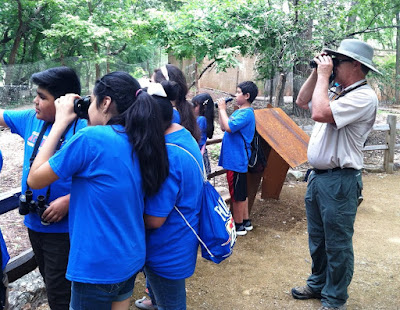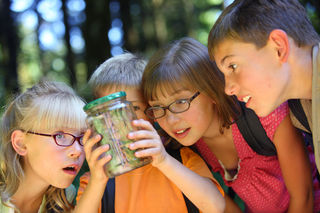Through Community Development Block Grants administered through the City of Oklahoma City and in partnership with Oklahoma City Public Schools, OKAN, the Oklahoma Expanded Learning Network, organized two STEAM academies.
 The STEAM summer academy for Eugene Field Elementary School students ended with an outing to Martin Nature Park and hands-on instruction and activities led by experts.
The STEAM summer academy for Eugene Field Elementary School students ended with an outing to Martin Nature Park and hands-on instruction and activities led by experts.
Presenters for the "Martin Nature Park Outing" were William "Bill" Diffin, president of the Central Oklahoma Audubon Society; Linda Daxon, Central Oklahoma Beekeepers Association and an OKC realtor; Paul Olson, Ph.D., plant biologist from the University of Central Oklahoma; his son and assistant Luke; Kim Shaw, Blue Thumb education coordinator, Oklahoma Conservation Department; Kim's intern Ariel McAffrey; Karla Beatty, education coordinator, carbon/soil health program, Oklahoma Conservation Department; and Denise Ebersbach, Edmond community volunteer.
These Eugene Field students knew their Oklahoma birds and eagerly raised their hands to answer Diffin's inquiries.

Diffin really made birding fun. Following a review of bird types the students would likely see and an adjustment of binoculars, the group went outdoors to "bird."

Diffin even offered his own more expensive binoculars to one of the students who had a malfunctioning binoculars.
Martin Nature Park has many trails to explore, and Diffin as well as Dr. Olson had made previous trips to the park just to reconnoiter.
He even brought bags of cat food so the fifth graders could feed the turtles and catfish. Yes, there some some catfood-gorged turtles and catfish that day.
Bees
Another portion of the nature outing curriculum featured bees. Linda Daxon, beekeeper or apiarist, gave each rotating group a riveting lesson about bees. When Denise Ebersbach asked students fresh from Daxon's presentation what they liked and learned, without hesitation they recounted much of what Daxon presented.
 |
| The Buzzzzz About Honey Bees |
Daxon's wearing her bee suit and helmet with veil was exciting. With much thought and creativity, she created her own flip-chart presentation.
Normally she did not wear special shoes because bees instinctively attack enemies' eyes, hence beekeepers' wearing helmets.
As the photo shows, Daxon brought many items related to beekeeping and honey. On the right of the photo is a hive box. She also pulled a hive frame and allowed each student to taste both the fresh honey comb and pure honey.

In addition, she picked fresh flowers to show pollen which bees collect and spread, stressed that bees are essential in pollinating crops, explained colony collapse, and gave scientific data about insecticides effect on bees, their honey, and their honeycomb--thus on us humans.
Daxon does collect some of her bees' honey and other some products that the hive produces such as beeswax, propolis, pollen, and royal jelly.
From one of her posters:
"Did you know there are
- about 25,000 types of bees in the world
- about 4,000 types live in the U.S."
 From another poster:
From another poster:
"Today we are going to talk about honey bees.
The honey bee is the only insect that makes something humans eat...honey!
The average American eats about 1.31 pounds of honey a year.
How many bees visiting how many flowers does it take to make a pound of honey?"
Although Daxon did not mention this site, The Canadian Honey Council says the answer is "two million flowers and fly 50,000 miles (80,000 km) to make one pound (454 g) of honey."
Also "A single honey bee makes about 1 and ½ teaspoons of honey during its lifetime."
http://www.honeycouncil.ca/chc_poundofhoney.php
This information certainly increases the value of honey and appreciation of a bee, doesn't it?

The group photo--Eugene Field STEAM academy students, teachers, chaperones, and presenters.
The Boren Mentoring Initiative's Bev Woodrome cold-called the passionate experts to volunteer their time and expertise. Cedric Currin-Moore, OKAN's STEM director, coordinated the logistics of the day with Oklahoma City Public Schools. School bus transportation and schedule, sun screen, bug spray, drinks, and sack lunches are part of the preparations. The students left the school, arrived by bus about 9:15 a.m. and departed at 2:00 p.m.
This is a model that can be adapted on a different scale for local communities or a specific school or class. Look around at the experts--professional and amateur--in your community.










 "Dr. Paul" in true Aristotelian fashion used the peripatetic teaching method. As a plant biologist, subject matter was everywhere--up, down, and all around. As he was about to begin with one of the rotating groups of students, Luke, his son strikes a pose.
"Dr. Paul" in true Aristotelian fashion used the peripatetic teaching method. As a plant biologist, subject matter was everywhere--up, down, and all around. As he was about to begin with one of the rotating groups of students, Luke, his son strikes a pose. 








"Nature's Peace Will Flow Into You...While Cares Drop Off Like Autumn Leaves"
5 Ways Outdoor Learning Optimizes Children's Overall Well-Being
Outdoor Learning Improves Well-Being by Creating 5 Outcomes:
Conclusion: Access to Nature Improves Well-Being Throughout Your Lifespan